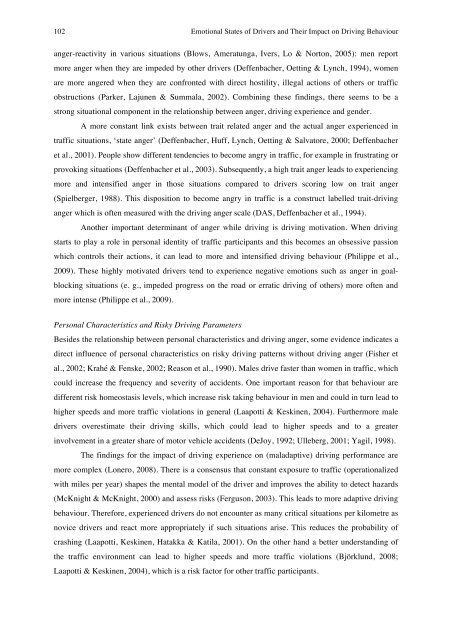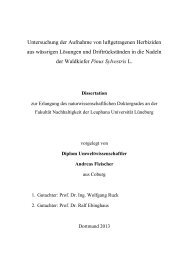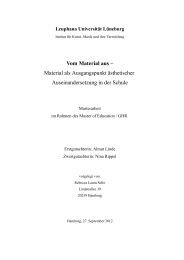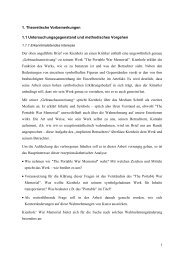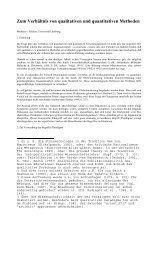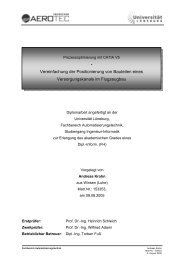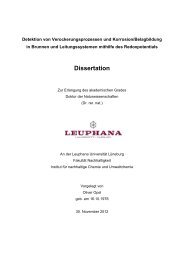Determinants of Emotional Experiences in Traffic Situations ... - OPUS
Determinants of Emotional Experiences in Traffic Situations ... - OPUS
Determinants of Emotional Experiences in Traffic Situations ... - OPUS
Create successful ePaper yourself
Turn your PDF publications into a flip-book with our unique Google optimized e-Paper software.
102 <strong>Emotional</strong> States <strong>of</strong> Drivers and Their Impact on Driv<strong>in</strong>g Behaviour!<br />
anger-reactivity <strong>in</strong> various situations (Blows, Ameratunga, Ivers, Lo & Norton, 2005): men report<br />
more anger when they are impeded by other drivers (Deffenbacher, Oett<strong>in</strong>g & Lynch, 1994), women<br />
are more angered when they are confronted with direct hostility, illegal actions <strong>of</strong> others or traffic<br />
obstructions (Parker, Lajunen & Summala, 2002). Comb<strong>in</strong><strong>in</strong>g these f<strong>in</strong>d<strong>in</strong>gs, there seems to be a<br />
strong situational component <strong>in</strong> the relationship between anger, driv<strong>in</strong>g experience and gender.<br />
A more constant l<strong>in</strong>k exists between trait related anger and the actual anger experienced <strong>in</strong><br />
traffic situations, ‘state anger’ (Deffenbacher, Huff, Lynch, Oett<strong>in</strong>g & Salvatore, 2000; Deffenbacher<br />
et al., 2001). People show different tendencies to become angry <strong>in</strong> traffic, for example <strong>in</strong> frustrat<strong>in</strong>g or<br />
provok<strong>in</strong>g situations (Deffenbacher et al., 2003). Subsequently, a high trait anger leads to experienc<strong>in</strong>g<br />
more and <strong>in</strong>tensified anger <strong>in</strong> those situations compared to drivers scor<strong>in</strong>g low on trait anger<br />
(Spielberger, 1988). This disposition to become angry <strong>in</strong> traffic is a construct labelled trait-driv<strong>in</strong>g<br />
anger which is <strong>of</strong>ten measured with the driv<strong>in</strong>g anger scale (DAS, Deffenbacher et al., 1994).<br />
Another important determ<strong>in</strong>ant <strong>of</strong> anger while driv<strong>in</strong>g is driv<strong>in</strong>g motivation. When driv<strong>in</strong>g<br />
starts to play a role <strong>in</strong> personal identity <strong>of</strong> traffic participants and this becomes an obsessive passion<br />
which controls their actions, it can lead to more and <strong>in</strong>tensified driv<strong>in</strong>g behaviour (Philippe et al.,<br />
2009). These highly motivated drivers tend to experience negative emotions such as anger <strong>in</strong> goalblock<strong>in</strong>g<br />
situations (e. g., impeded progress on the road or erratic driv<strong>in</strong>g <strong>of</strong> others) more <strong>of</strong>ten and<br />
more <strong>in</strong>tense (Philippe et al., 2009).<br />
Personal Characteristics and Risky Driv<strong>in</strong>g Parameters<br />
Besides the relationship between personal characteristics and driv<strong>in</strong>g anger, some evidence <strong>in</strong>dicates a<br />
direct <strong>in</strong>fluence <strong>of</strong> personal characteristics on risky driv<strong>in</strong>g patterns without driv<strong>in</strong>g anger (Fisher et<br />
al., 2002; Krahé & Fenske, 2002; Reason et al., 1990). Males drive faster than women <strong>in</strong> traffic, which<br />
could <strong>in</strong>crease the frequency and severity <strong>of</strong> accidents. One important reason for that behaviour are<br />
different risk homeostasis levels, which <strong>in</strong>crease risk tak<strong>in</strong>g behaviour <strong>in</strong> men and could <strong>in</strong> turn lead to<br />
higher speeds and more traffic violations <strong>in</strong> general (Laapotti & Kesk<strong>in</strong>en, 2004). Furthermore male<br />
drivers overestimate their driv<strong>in</strong>g skills, which could lead to higher speeds and to a greater<br />
<strong>in</strong>volvement <strong>in</strong> a greater share <strong>of</strong> motor vehicle accidents (DeJoy, 1992; Ulleberg, 2001; Yagil, 1998).<br />
The f<strong>in</strong>d<strong>in</strong>gs for the impact <strong>of</strong> driv<strong>in</strong>g experience on (maladaptive) driv<strong>in</strong>g performance are<br />
more complex (Lonero, 2008). There is a consensus that constant exposure to traffic (operationalized<br />
with miles per year) shapes the mental model <strong>of</strong> the driver and improves the ability to detect hazards<br />
(McKnight & McKnight, 2000) and assess risks (Ferguson, 2003). This leads to more adaptive driv<strong>in</strong>g<br />
behaviour. Therefore, experienced drivers do not encounter as many critical situations per kilometre as<br />
novice drivers and react more appropriately if such situations arise. This reduces the probability <strong>of</strong><br />
crash<strong>in</strong>g (Laapotti, Kesk<strong>in</strong>en, Hatakka & Katila, 2001). On the other hand a better understand<strong>in</strong>g <strong>of</strong><br />
the traffic environment can lead to higher speeds and more traffic violations (Björklund, 2008;<br />
Laapotti & Kesk<strong>in</strong>en, 2004), which is a risk factor for other traffic participants.


